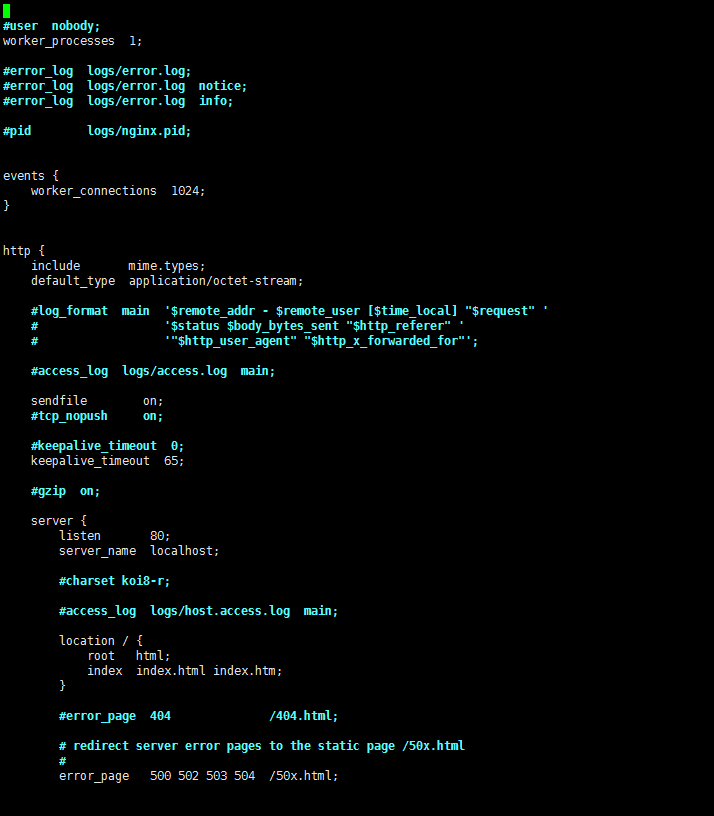Nginx 配置参数详解
默认配置文件在 nginx 目录下的 conf/nginx.conf 内容大概如下:

所有我就把它分为 全局配置、events 、http 吧
一、全局区配置
1
2
3
4
5
6
7
8
9
10
11
12
13
14
15
16
17
18
19
20
21
| # 运行用户与用户组,用户组可忽略
user nobody;
# worker进程的个数,通常应该略少于或等于CPU物理核心数,也可以使用auto自动获取
worker_processes 1
# 指定所有worker进程所能打开的最大文件句柄数,系统的默认值可通过 ` ulimit -n` 查看,一般都是1024
worker_rlimit_nofile 100000;
# 生成错误日志的地址,默认是nginx 目录下的logs/error.log
error_log logs/error.log
# 指定nginx守护进程的pid文件,默认默认是nginx 目录下的logs/nginx.pid
pid logs/nginx.pid
# 是否以守护进程方式运行nginx;调试时应该设置为off
daemon {on|off}
# 是否以master/worker模型来运行;调试时可以设置为off
master_process {on|off}
|
二、events 事件相关的配置
1
2
3
4
5
6
7
8
9
10
11
12
13
14
15
16
17
18
19
| events {
# 单个worker进程打开的最大并发连接数,worker_processes*worker_connections
worker_connections 1024;
# 指明使用的事件模型:建议让Nginx自行选择,linux建议epoll,FreeBSD建议采用kqueue,window下不指定。
use [epoll|rtsig|select|poll];
# keepalive超时时间。
keepalive_timeout 60;
# 这个将为打开文件指定缓存,默认是没有启用的,max指定缓存数量,建议和打开文件数一致,inactive是指经过多长时间文件没被请求后删除缓存。
open_file_cache max=65535 inactive=60s;
# 这个是指多长时间检查一次缓存的有效信息。
open_file_cache_valid 80s;
}
|
三、http 服务器配置
1
2
3
4
5
6
7
8
9
10
11
12
13
14
15
16
17
18
19
20
21
22
23
24
25
26
27
28
29
30
31
32
33
34
35
36
37
38
39
40
41
42
43
44
45
46
47
48
49
50
51
52
53
54
55
56
57
58
59
60
61
62
63
64
65
66
67
68
69
70
71
72
73
74
75
76
77
78
79
80
81
82
83
84
85
86
87
88
89
90
91
92
93
94
95
96
97
98
99
100
101
102
103
104
105
106
107
108
109
110
111
112
113
114
115
116
117
118
119
120
121
122
123
124
125
126
127
128
129
130
131
132
133
134
135
136
137
138
139
140
141
142
143
144
145
146
147
148
149
150
151
152
153
154
155
156
157
158
159
160
161
162
163
164
165
166
167
168
169
170
171
172
173
174
175
176
177
178
179
180
181
182
183
184
185
186
187
188
189
190
191
192
193
194
195
196
197
198
199
200
201
202
| http {
# include指在当前文件中包含另一个文件内容
# 设定mime类型,类型由mime.type文件定义
include conf/mime.types;
# 这里是代理的配置文件,建议另建立一个proxy.conf 然后在这里include 进行引用。
include /etc/nginx/proxy.conf;
#添加fastcgi 的配置,具体可看官网栗子:https://www.nginx.com/resources/wiki/start/topics/examples/fastcgiexample/
include /etc/nginx/fastcgi.conf;
# 首页索引
index index.html index.htm index.php;
#设置文件使用默认的mine-type
default_type application/octet-stream;
# 日志格式设置。
# $remote_addr与$http_x_forwarded_for用以记录客户端的ip地址;
# $remote_user:用来记录客户端用户名称;
# $time_local: 用来记录访问时间与时区;
# $status: 用来记录请求状态;成功是200,
# $request: 用来记录请求的url与http协议;
# $body_bytes_sent :记录发送给客户端文件主体内容大小;
# $http_referer:用来记录从那个页面链接访问过来的;
# $http_user_agent:记录客户浏览器的相关信息;
log_format main '$remote_addr - $remote_user [$time_local] $status '
'"$request" $body_bytes_sent "$http_referer" '
'"$http_user_agent" "$http_x_forwarded_for"';
log_format mylog '$remote_addr - "$http_x_forwarded_for" - $remote_user [$time_local] $status '
'"$request" $body_bytes_sent "$http_referer" '
'"$http_user_agent" ';
# 声明log log位置 log格式;
access_log logs/access_8080.log mylog;
# sendfile指令指定 nginx 是否调用sendfile 函数(zero copy 方式)来输出文件,对于普通应用,应设为on。如果用来进行下载等应用磁盘IO重负载应用,可设置为off,以平衡磁盘与网络IO处理速度,降低系统uptime
sendfile on;
# 打开linux下TCP_CORK,sendfile打开时才有效,作减少报文段的数量之用
tcp_nopush on;
# 保存服务器名字的hash表 大小,如果server很多,就调大一点
server_names_hash_bucket_size 128; # this seems to be required for some vhosts
#在一个长连接所能够允许请求的最大资源数
keepalive_requests 20;
#为制定类型的User Agent禁用长连接
keepalive_disable [msie6|safari|none];
#是否对长连接使用TCP_NODELAY选项,不将多个小文件合并传输
tcp_nodelay on;
#设置nginx采用gzip压缩的形式发送数据,减少发送数据量,但会增加请求处理时间及CPU处理时间,需要权衡
gzip on;
#加vary给代理服务器使用,针对有的浏览器支持压缩,有个不支持,根据客户端的HTTP头来判断是否需要压缩
gzip_vary on;
#nginx在压缩资源之前,先查找是否有预先gzip处理过的资源
#!gzip_static on;
#为指定的客户端禁用gzip功能
gzip_disable "MSIE[1-6]\.";
#允许或禁止压缩基于请求和相应的响应流,any代表压缩所有请求
gzip_proxied any;
#设置对数据启用压缩的最少字节数,如果请求小于1024字节则不压缩,会影响请求速度
gzip_min_length 1024;
#设置数据压缩等级,1-9之间,9最慢压缩比最大
gzip_comp_level 6;
#设置需要压缩的数据格式
gzip_types text/plain text/css text/xml text/javascript application/json application/x-javascript application/xml application/xml+rss;
#定义错误提示页面
error_page 500 502 503 504 /50x.html;
location = /50x.html {
root html;
}
# PHP
server { # php/fastcgi
listen 80;
server_name domain1.com www.domain1.com;
access_log logs/domain1.access.log main;
root html;
location ~ \.php$ {
fastcgi_pass 127.0.0.1:1025;
}
}
# JSP
server {
listen 80;
server_name jspServer;
access_log logs/tomcat.access.log main;
root /usr/local/tomcat/webapps/ROOT;
location ~ \.jsp${
proxy_pass http://127.0.0.1:8080;
index index.jsp;
}
}
# 这里可以弄一个静态资源访问服务器
server { # simple reverse-proxy
#监听80端口
listen 80;
#定义主机名,主机名可以有多个,名称还可以使用正则表达式(~)或通配符
#(1)先做精确匹配检查
#(2)左侧通配符匹配检查:*.lrshuai.top
#(3)右侧通配符匹配检查:mail.*
#(4)正则表达式匹配检查:如~^.*\.lrshuai\.top$
#(5)detault_server
server_name lrshuai.top www.lrshuai.top;
#设定主机的访问日志
access_log logs/blog.access.log main;
# serve static files - 静态文件过滤
location ~ ^/(images|javascript|js|css|flash|media|static)/ {
# 定义服务器的默认网站根目录位置
root /var/www/virtual/big.server.com/htdocs;
# expires 30s 缓存30秒;
# expires 30m 缓存30分钟;
# expires 2h 缓存2小时;
# expires 30d 缓存30天;
expires 30d;
}
# pass requests for dynamic content to rails/turbogears/zope, et al
# 负载,请求转发到8080端口的服务器
location / {
proxy_pass http://127.0.0.1:8080;
}
location /xuanx {
rewrite ^/xuanx/(.*)$ /$1 break; # 去掉 /xuanx 前缀并转发到 /
proxy_pass http://localhost:8800; # 反向代理
proxy_set_header Host $host; # 设置 Host 头
proxy_set_header X-Real-IP $remote_addr; # 设置真实 IP
proxy_set_header X-Forwarded-For $proxy_add_x_forwarded_for; # 设置转发的 IP
proxy_set_header X-Forwarded-Proto $scheme; # 设置转发的协议
# 优化配置
proxy_connect_timeout 60s;
proxy_read_timeout 600s;
client_max_body_size 20M;
}
}
# 定义负载均衡服务器列表,名字为:big_server_com
# weight参数表示权重值,权值越高被分配到的几率越大
upstream big_server_com {
# 每个请求按访问ip的hash结果分配,这样每个访客固定访问一个后端服务器,可以解决session的问题。
ip_hash;
server 127.0.0.3:8000 weight=5;
server 127.0.0.3:8001 weight=5;
server 192.168.0.1:8000;
server 192.168.0.1:8001;
}
# 负载均衡配置
server { # simple load balancing
listen 80;
server_name big.server.com;
access_log logs/big.server.access.log main;
# location [=|~|~*|^~] uri {...}
# 功能:允许根据用户请求的URI来匹配定义的个location,匹配到时,此请求将被相应的location配置块中的配置所处理
# =:表示精确匹配检查
# ~:正则表达式模式匹配检查,区分字符大小写
# ~*:正则表达式模式匹配检查,不区分字符大小写
# ^~:URI的前半部分匹配,不支持正则表达式
# !~:开头表示区分大小写的不匹配的正则
# !~*:开头表示不区分大小写的不匹配的正则
# /:通用匹配,任何请求都会被匹配到
location / {
#引用反向代理的配置,配置文件目录根据编译参数而定
#如果编译时加入了--conf-path=/etc/nginx/nginx.conf指定了配置文件的路径那么就把proxy.conf放在/etc/nginx/目录下
#如果没有制定配置文件路径那么就把proxy.conf配置放到nginx的conf目录下,要么写绝对路径
include proxy.conf;
# 定义后端负载服务器组
proxy_pass http://big_server_com;
}
}
}
|
proxy.conf
1
2
3
4
5
6
7
8
9
10
11
12
13
14
15
16
17
18
19
20
21
| # 后端的服务器可以通过X-Forwarded-For获取用户真实IP
proxy_redirect off;
proxy_set_header Host $host;
proxy_set_header X-Real-IP $remote_addr;
proxy_set_header X-Forwarded-For $proxy_add_x_forwarded_for;
# 允许客户端请求的最大单文件字节数
client_max_body_size 10m;
client_body_buffer_size 512k;
# nginx跟后端服务器连接超时时间(代理连接超时)
proxy_connect_timeout 90;
# 后端服务器数据回传时间(代理发送超时)
proxy_send_timeout 90;
# 连接成功后,后端服务器响应时间(代理接收超时)
proxy_read_timeout 90;
#proxy_buffers缓冲区,网页平均在32k以下的设置
proxy_buffers 32 4k;
|
fastcgi.conf
1
2
3
4
5
6
7
8
9
10
11
12
13
14
15
16
17
18
19
20
21
| fastcgi_param SCRIPT_FILENAME $document_root$fastcgi_script_name;
fastcgi_param QUERY_STRING $query_string;
fastcgi_param REQUEST_METHOD $request_method;
fastcgi_param CONTENT_TYPE $content_type;
fastcgi_param CONTENT_LENGTH $content_length;
fastcgi_param SCRIPT_NAME $fastcgi_script_name;
fastcgi_param REQUEST_URI $request_uri;
fastcgi_param DOCUMENT_URI $document_uri;
fastcgi_param DOCUMENT_ROOT $document_root;
fastcgi_param SERVER_PROTOCOL $server_protocol;
fastcgi_param GATEWAY_INTERFACE CGI/1.1;
fastcgi_param SERVER_SOFTWARE nginx/$nginx_version;
fastcgi_param REMOTE_ADDR $remote_addr;
fastcgi_param REMOTE_PORT $remote_port;
fastcgi_param SERVER_ADDR $server_addr;
fastcgi_param SERVER_PORT $server_port;
fastcgi_param SERVER_NAME $server_name;
fastcgi_index index.php;
fastcgi_param REDIRECT_STATUS 200;
|
四、其他补充
1、查看Nginx状态
1
2
3
4
5
6
7
8
9
10
11
12
13
14
15
16
17
18
19
20
21
| # 设定查看Nginx状态的地址
# 只能定义在location中
location /Status {
stub_status on;
# 允许所有ip
allow all;
#access_log off;
#allow 192.168.1.0/24;
#deny all;
#auth_basic "Status";
#auth_basic_user_file /etc/nginx/.htpasswd;
}
# status结果实例说明:
# Active connections: 1 (当前所有处于打开状态的连接数)
# server accepts handled requests
# 174(已经接受进来的连接) 174(已经处理过的连接) 492(处理的请求,在保持连接模式下,请求数可能会多于连接数量)
# Reading: 0 Writing: 1 Waiting: 0
# Reading:正处于接受请求状态的连接数
# Writing:请求接受完成,正处于处理请求或发送相应的过程中的连接数
# Waiting:保持连接模式,且处于活动状态的连接数
|
2、防盗链
1
2
3
4
5
6
7
8
9
| location ~* \.(jpg|gif|jpeg|png)$ {
# 当一个请求头的Referer字段中包含一些非正确的字段,这个模块可以禁止这个请求访问站点,这个指令在referer头的基础上为 $invalid_referer 变量赋值,其值为0或1
# 如果valid_referers列表中没有Referer头的值, $invalid_referer将被设置为1
# 下面的意思是如果来路不是来自 lrshuai.top 域 将跳转403页面
valid_referer none blocked www.lrshuai.top *.lrshuai.top;
if ($invalid_referer) {
rewrite ^/ http://www.lrshuai.top/403.html;
}
}
|
3、rewrite 重定向,限制IE访问
1
2
3
4
5
| # 若是ie 浏览器,将重定向到ie.html
if ($http_user_agent ~ MSIE) {
rewrite ^.*$ /ie.htm;
break; #(不break会循环重定向)
}
|
4、限制ip访问
1
2
3
4
5
6
7
8
| location /{
# 网段192.168.1.0 这个网段全部不给访问
deny 192.168.1.0/24;
allow 192.168.12.0/24;
# 可以重定向
# rewrite ...
}
|
参考自:https://www.nginx.com/resources/wiki/start/topics/examples/full/


